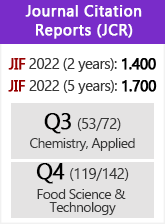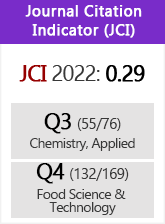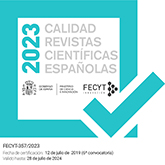Utilization of unsaponifiable matter from rice bran oil fatty acid distillate for preparing an antioxidant-rich oleogel and evaluation of its properties
DOI:
https://doi.org/10.3989/gya.0938182Keywords:
Oleogels, RBOFAD, Rice bran oil, Rice bran wax, UMRBOFADAbstract
Rice bran oil fatty acid distillate (RBOFAD) is an important by-product obtained from the physical refining process. This fatty acid distillate contains high a amount of Unsaponifiable Matter (γ-oryzanol 3.27 gm/100gm UM; total tocopherol 10.93 mg/100 g UM; total phytosterol 21.81 g/100g UM; squalene 1.15 g/100 g UM and total fatty alcohol 73.34 g/100 g UM) and free fatty acids. Antioxidant-rich Oleogels were obtained from rice bran wax (RBW), rice bran oil fatty acid distillate (RBOFAD) and refined rice bran oil. The main objective of this study was to utilize the antioxidant-rich unsaponifiable matter of RBOFAD (UMRBOFAD) as an organogelator along with rice bran wax, which also acts as a good organogelator. Antioxidant-rich oleogel was prepared using UMRBFAD, ethylcellulose (EC) and RBW at 2%, 2%, 3% on weight basis, respectively, in refined rice bran oil and this antioxidant-rich oleogel was compared with rice bran oil oleogel using RBW at 7% on weight basis of rice bran oil. These oleogels were evaluated using a combination of techniques such as differential scanning calorimetry (DSC), polarized light microscopy (PLM), Viscosity, synchrotron radiation X-ray diffraction (SR-XRD) and FTIR Spectroscopy. The differential scanning calorimetry (DSC) measured the thermal properties of rice bran oil oleogel and high antioxidant-rich oleogel. Polarized light microscopy images revealed needle-like crystals for RBW. SR-XRD measurements were used for clarification of the crystal structures of the building blocks of these oleogels. The antioxidant activities of oleogels were evaluated involving DPPH and ABTS assays.
Downloads
References
Ahmad Nayik G, Majid I, Gull A, Muzaffar K. 2015. Rice bran oil, the future edible oil of India: A mini Review. Rice Res. Open Access 03, 1-3. https://doi.org/10.4172/2375-4338.1000151
Bin Sintang MD, Rimaux T, Walle DV, Dewettinck K, Patel AR. 2016. Oil structuring properties of monoglycerides and phytosterols mixtures. Eur. J. Lipid Sci. Technol. 119, 1500517. https://doi.org/10.1002/ejlt.201500517
Calligaris S, Mirolo G, Pieve SD, Arrighetti G, Nicoli MC. 2013. Effect of Oil Type on Formation, Structure and Thermal Properties of ?-oryzanol and ?-sitosterol-Based Organogels. Food Biophys. 9, 69-75. https://doi.org/10.1007/s11483-013-9318-z
Chen M-H, Bergman CJ. 2005. A rapid procedure for analysing rice bran tocopherol, tocotrienol and g-oryzanol contents. J. Food Compos. Anal. 18, 139-151. https://doi.org/10.1016/j.jfca.2003.09.004
Dassanayake LSK, Kodali DR, Ueno S. 2011. Formation of oleogels based on edible lipid materials. Curr. Opin. Colloid Interface Sci. 16, 432-439. https://doi.org/10.1016/j.cocis.2011.05.005
Doan CD, Walle DV, Dewettinck K, Patel AR. 2015. Evaluating the Oil-Gelling Properties of Natural Waxes in Rice Bran Oil: Rheological, Thermal, and Microstructural Study. J. Am. Oil Chem. Soc. 92, 801-811. https://doi.org/10.1007/s11746-015-2645-0
Escrich E, Solanas M, Moral R. 2014. Olive Oil and Other Dietary Lipids in Breast Cancer. in Cancer Treatment and Research. Advances in Nutrition and Cancer 31, 289-309. https://doi.org/10.1007/978-3-642-38007-5_17 PMid:24114487
Gómez-Estaca J, Herrero AM, Herranz B, Alvarez MD, Jimenez-Colmenero F, Cofrades S. 2019. Characterization of ethyl cellulose and beeswax oleogels and their suitability as fat replacers in healthier lipid pâtés development. Food Hydrocoll. 87, 960-969 https://doi.org/10.1016/j.foodhyd.2018.09.029
Gupta AK, Savopoulos CG, Ahuja J, Hatzitolios AI. 2011. Role of phytosterols in lipid-lowering: current perspectives. QJM 104, 301-308. https://doi.org/10.1093/qjmed/hcr007 PMid:21325285
Hwang H-S, Singh M, Bakota EL, Winkler-Moser JK, Kim S, Liu SX. 2013. Margarine from Organogels of Plant Wax and Soybean Oil. J. Am. Oil Chem. Soc. 90, 1705-1712. https://doi.org/10.1007/s11746-013-2315-z
Hwang H-S, Kim S, Singh M, Winkler-Moser JK, Liu SX . 2011. Organogel Formation of Soybean Oil with Waxes. J. Am. Oil Chem. Soc. 89, 639-647. https://doi.org/10.1007/s11746-011-1953-2
Jayathilake C, Rizliya V, Liyanage R. 2016. Antioxidant and Free Radical Scavenging Capacity of Extensively Used Medicinal Plants in Sri Lanka. Procedia Food Sci. 6, 123-126. https://doi.org/10.1016/j.profoo.2016.02.028
Li X, Wu X, Huang L. 2009. Correlation between Antioxidant Activities and Phenolic Contents of Radix Angelicae Sinensis (Danggui). Molecules 14, 5349-5361. https://doi.org/10.3390/molecules14125349 PMid:20032898 PMCid:PMC6255375
Nijjar PS, Burke FM, Bloesch A, Rader DJ. 2010. Role of dietary supplements in lowering low-density lipoprotein cholesterol: A review. J. Clin. Lipidol. 4, 248-258. https://doi.org/10.1016/j.jacl.2010.07.001 PMid:21122657
Ögütcü M, Arifoglu N, Yılmaz E. 2015. Storage stability of cod liver oil organogels formed with beeswax and carnauba wax. Int. J. Food Sci. Technol. 50, 404-412. https://doi.org/10.1111/ijfs.12612
Patel AR, Dewettinck K. 2015. Comparative evaluation of structured oil systems: Shellac oleogel, HPMC oleogel, and HIPE gel. Eur. J. Lipid Sci. Technol. 117, 1772-1781. https://doi.org/10.1002/ejlt.201400553 PMid:26726293 PMCid:PMC4690198
Pengkumsri N, Chaiyasut C, Sivamaruthi BS, Saenjum C, Sirilun S, Peerajan S, Suwannalert P, Sirisattha S, Chaiyasut K, Kesika P. 2015. The influence of extraction methods on composition and antioxidant properties of rice bran oil. Food Sci. Technol. 35, 493-501. https://doi.org/10.1590/1678-457X.6730
Sahu S, Ghosh M, Bhattacharyya DK. 2018. Isolation of the unsaponifiable matter (squalene, phytosterols, tocopherols, ?-oryzanol and fatty alcohols) from a fatty acid distillate of rice bran oil. Grasas Aceites 69, e262. https://doi.org/10.3989/gya.1112172
Stortz TA, Marangoni AG. 2014. The replacement for petrolatum: Thixotropic ethylcellulose oleogels in triglyceride oils. Green Chem. https://doi.org/10.1039/C4GC00052H
Troni KL, Silva SM, Meirelles AJA, Ceriani R. 2013. Study of Fatty Acid and Fatty Alcohol Formation from Hydrolysis of Rice Bran Wax. Chem. Eng. Trans. 32, 1747-1752.
Yang S, Li G, Saleh ASM. 2017. Functional Characteristics of Oleogel Prepared from Sunflower Oil with ?-Sitosterol and Stearic Acid. J. Am. Oil Chem. Soc. 94, 1153-1164. https://doi.org/10.1007/s11746-017-3026-7
Yılmaz E, Ö?ütcü M. 2014. Properties and Stability of Hazelnut Oil Organogels with Beeswax and Monoglyceride. J. Am. Oil Chem. Soc. 91, 1007-1017. https://doi.org/10.1007/s11746-014-2434-1
Zetzl AK, Gravelle AJ, Kurylowicz M, Dutcher J, Barbut S, Marangoni AG. 2014. Microstructure of ethylcellulose oleogels and its relationship to mechanical properties. Food Struct. 2, 27-40. https://doi.org/10.1016/j.foostr.2014.07.002
Published
How to Cite
Issue
Section
License
Copyright (c) 2020 Consejo Superior de Investigaciones Científicas (CSIC)

This work is licensed under a Creative Commons Attribution 4.0 International License.
© CSIC. Manuscripts published in both the printed and online versions of this Journal are the property of Consejo Superior de Investigaciones Científicas, and quoting this source is a requirement for any partial or full reproduction.All contents of this electronic edition, except where otherwise noted, are distributed under a “Creative Commons Attribution 4.0 International” (CC BY 4.0) License. You may read here the basic information and the legal text of the license. The indication of the CC BY 4.0 License must be expressly stated in this way when necessary.
Self-archiving in repositories, personal webpages or similar, of any version other than the published by the Editor, is not allowed.
















